Accounting Research: ACC800 Research in Accounting Practice Assignment
VerifiedAdded on 2020/04/07
|14
|3156
|269
Homework Assignment
AI Summary
This assignment solution for ACC800, Research in Accounting Practice, presents a comprehensive analysis of mobile advisory services within an accounting context. The research plan outlines a qualitative approach to investigate staff perspectives on mobile advisory services, focusing on advantages, challenges, and potential improvements. The methodology includes observation, interviews, questionnaires, and content analysis. The assignment also includes a discussion of explanatory sequential mixed methods and a literature review, summarizing key findings from academic papers on budgetary participation and managerial performance. The solution argues for the positive impact of budgetary participation on employee motivation and organizational outcomes, and it concludes with a brief discussion on the significance of culture.

ACC800 RESEARCH IN ACCOUNTING PRACTICE 1
Secure Best Marks with AI Grader
Need help grading? Try our AI Grader for instant feedback on your assignments.
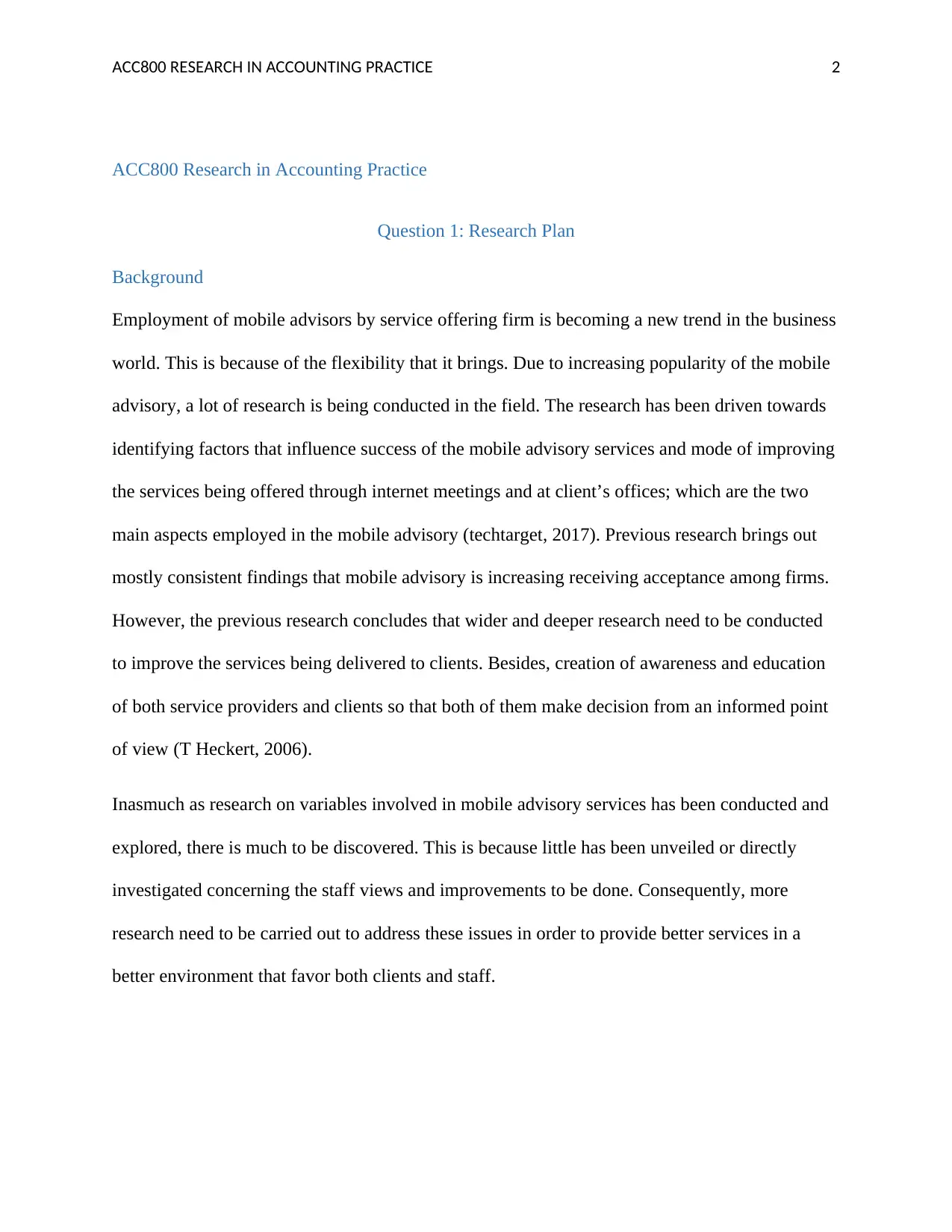
ACC800 RESEARCH IN ACCOUNTING PRACTICE 2
ACC800 Research in Accounting Practice
Question 1: Research Plan
Background
Employment of mobile advisors by service offering firm is becoming a new trend in the business
world. This is because of the flexibility that it brings. Due to increasing popularity of the mobile
advisory, a lot of research is being conducted in the field. The research has been driven towards
identifying factors that influence success of the mobile advisory services and mode of improving
the services being offered through internet meetings and at client’s offices; which are the two
main aspects employed in the mobile advisory (techtarget, 2017). Previous research brings out
mostly consistent findings that mobile advisory is increasing receiving acceptance among firms.
However, the previous research concludes that wider and deeper research need to be conducted
to improve the services being delivered to clients. Besides, creation of awareness and education
of both service providers and clients so that both of them make decision from an informed point
of view (T Heckert, 2006).
Inasmuch as research on variables involved in mobile advisory services has been conducted and
explored, there is much to be discovered. This is because little has been unveiled or directly
investigated concerning the staff views and improvements to be done. Consequently, more
research need to be carried out to address these issues in order to provide better services in a
better environment that favor both clients and staff.
ACC800 Research in Accounting Practice
Question 1: Research Plan
Background
Employment of mobile advisors by service offering firm is becoming a new trend in the business
world. This is because of the flexibility that it brings. Due to increasing popularity of the mobile
advisory, a lot of research is being conducted in the field. The research has been driven towards
identifying factors that influence success of the mobile advisory services and mode of improving
the services being offered through internet meetings and at client’s offices; which are the two
main aspects employed in the mobile advisory (techtarget, 2017). Previous research brings out
mostly consistent findings that mobile advisory is increasing receiving acceptance among firms.
However, the previous research concludes that wider and deeper research need to be conducted
to improve the services being delivered to clients. Besides, creation of awareness and education
of both service providers and clients so that both of them make decision from an informed point
of view (T Heckert, 2006).
Inasmuch as research on variables involved in mobile advisory services has been conducted and
explored, there is much to be discovered. This is because little has been unveiled or directly
investigated concerning the staff views and improvements to be done. Consequently, more
research need to be carried out to address these issues in order to provide better services in a
better environment that favor both clients and staff.
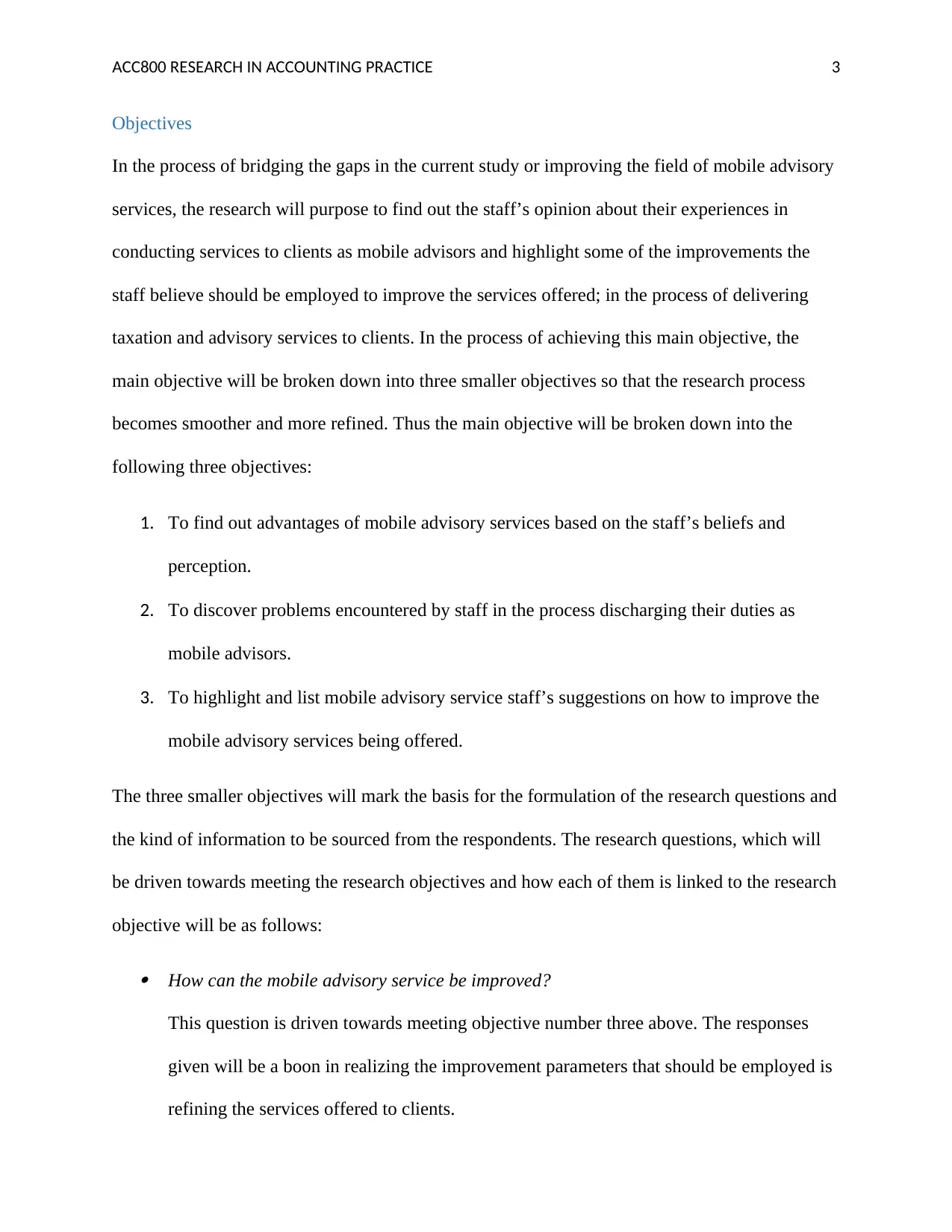
ACC800 RESEARCH IN ACCOUNTING PRACTICE 3
Objectives
In the process of bridging the gaps in the current study or improving the field of mobile advisory
services, the research will purpose to find out the staff’s opinion about their experiences in
conducting services to clients as mobile advisors and highlight some of the improvements the
staff believe should be employed to improve the services offered; in the process of delivering
taxation and advisory services to clients. In the process of achieving this main objective, the
main objective will be broken down into three smaller objectives so that the research process
becomes smoother and more refined. Thus the main objective will be broken down into the
following three objectives:
1. To find out advantages of mobile advisory services based on the staff’s beliefs and
perception.
2. To discover problems encountered by staff in the process discharging their duties as
mobile advisors.
3. To highlight and list mobile advisory service staff’s suggestions on how to improve the
mobile advisory services being offered.
The three smaller objectives will mark the basis for the formulation of the research questions and
the kind of information to be sourced from the respondents. The research questions, which will
be driven towards meeting the research objectives and how each of them is linked to the research
objective will be as follows:
How can the mobile advisory service be improved?
This question is driven towards meeting objective number three above. The responses
given will be a boon in realizing the improvement parameters that should be employed is
refining the services offered to clients.
Objectives
In the process of bridging the gaps in the current study or improving the field of mobile advisory
services, the research will purpose to find out the staff’s opinion about their experiences in
conducting services to clients as mobile advisors and highlight some of the improvements the
staff believe should be employed to improve the services offered; in the process of delivering
taxation and advisory services to clients. In the process of achieving this main objective, the
main objective will be broken down into three smaller objectives so that the research process
becomes smoother and more refined. Thus the main objective will be broken down into the
following three objectives:
1. To find out advantages of mobile advisory services based on the staff’s beliefs and
perception.
2. To discover problems encountered by staff in the process discharging their duties as
mobile advisors.
3. To highlight and list mobile advisory service staff’s suggestions on how to improve the
mobile advisory services being offered.
The three smaller objectives will mark the basis for the formulation of the research questions and
the kind of information to be sourced from the respondents. The research questions, which will
be driven towards meeting the research objectives and how each of them is linked to the research
objective will be as follows:
How can the mobile advisory service be improved?
This question is driven towards meeting objective number three above. The responses
given will be a boon in realizing the improvement parameters that should be employed is
refining the services offered to clients.
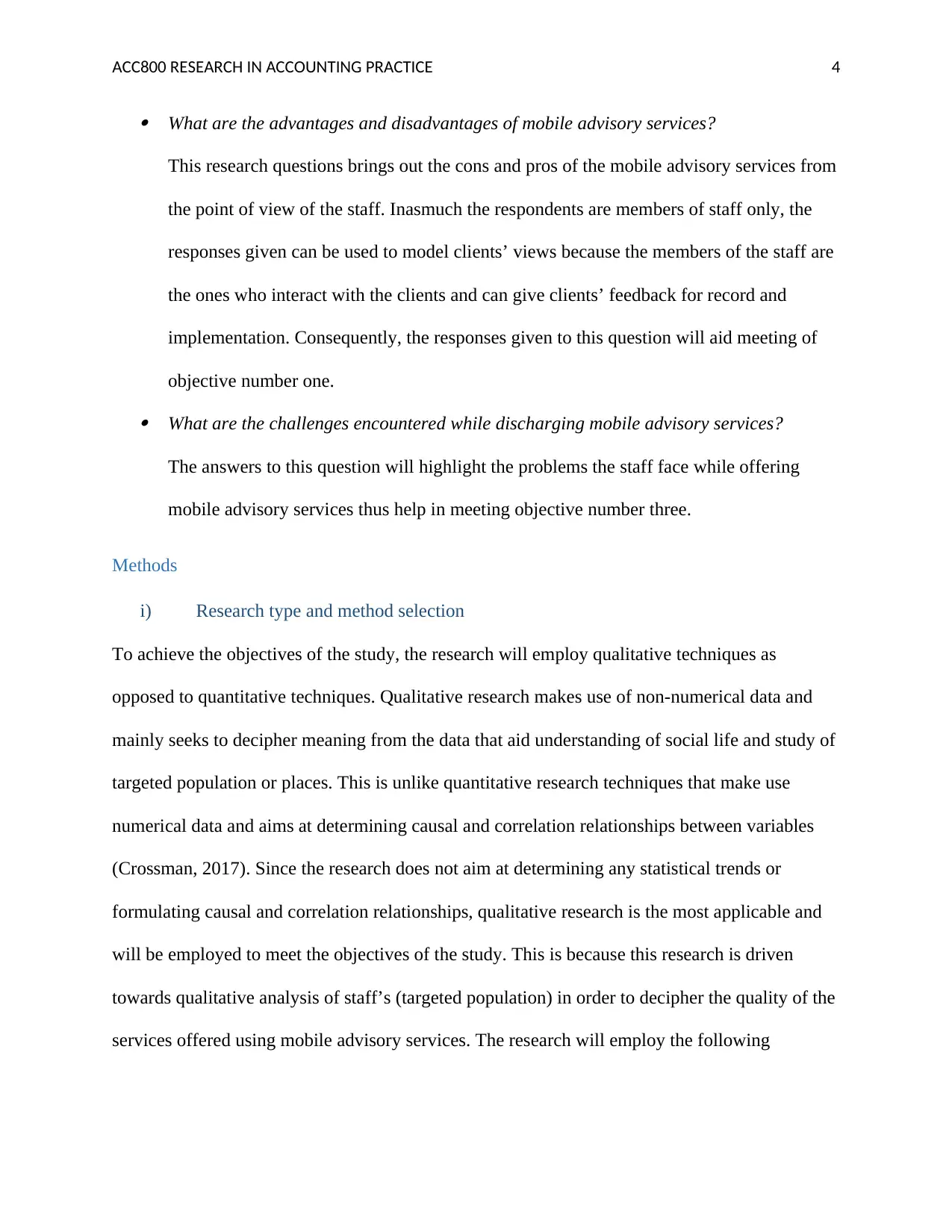
ACC800 RESEARCH IN ACCOUNTING PRACTICE 4
What are the advantages and disadvantages of mobile advisory services?
This research questions brings out the cons and pros of the mobile advisory services from
the point of view of the staff. Inasmuch the respondents are members of staff only, the
responses given can be used to model clients’ views because the members of the staff are
the ones who interact with the clients and can give clients’ feedback for record and
implementation. Consequently, the responses given to this question will aid meeting of
objective number one. What are the challenges encountered while discharging mobile advisory services?
The answers to this question will highlight the problems the staff face while offering
mobile advisory services thus help in meeting objective number three.
Methods
i) Research type and method selection
To achieve the objectives of the study, the research will employ qualitative techniques as
opposed to quantitative techniques. Qualitative research makes use of non-numerical data and
mainly seeks to decipher meaning from the data that aid understanding of social life and study of
targeted population or places. This is unlike quantitative research techniques that make use
numerical data and aims at determining causal and correlation relationships between variables
(Crossman, 2017). Since the research does not aim at determining any statistical trends or
formulating causal and correlation relationships, qualitative research is the most applicable and
will be employed to meet the objectives of the study. This is because this research is driven
towards qualitative analysis of staff’s (targeted population) in order to decipher the quality of the
services offered using mobile advisory services. The research will employ the following
What are the advantages and disadvantages of mobile advisory services?
This research questions brings out the cons and pros of the mobile advisory services from
the point of view of the staff. Inasmuch the respondents are members of staff only, the
responses given can be used to model clients’ views because the members of the staff are
the ones who interact with the clients and can give clients’ feedback for record and
implementation. Consequently, the responses given to this question will aid meeting of
objective number one. What are the challenges encountered while discharging mobile advisory services?
The answers to this question will highlight the problems the staff face while offering
mobile advisory services thus help in meeting objective number three.
Methods
i) Research type and method selection
To achieve the objectives of the study, the research will employ qualitative techniques as
opposed to quantitative techniques. Qualitative research makes use of non-numerical data and
mainly seeks to decipher meaning from the data that aid understanding of social life and study of
targeted population or places. This is unlike quantitative research techniques that make use
numerical data and aims at determining causal and correlation relationships between variables
(Crossman, 2017). Since the research does not aim at determining any statistical trends or
formulating causal and correlation relationships, qualitative research is the most applicable and
will be employed to meet the objectives of the study. This is because this research is driven
towards qualitative analysis of staff’s (targeted population) in order to decipher the quality of the
services offered using mobile advisory services. The research will employ the following
Secure Best Marks with AI Grader
Need help grading? Try our AI Grader for instant feedback on your assignments.
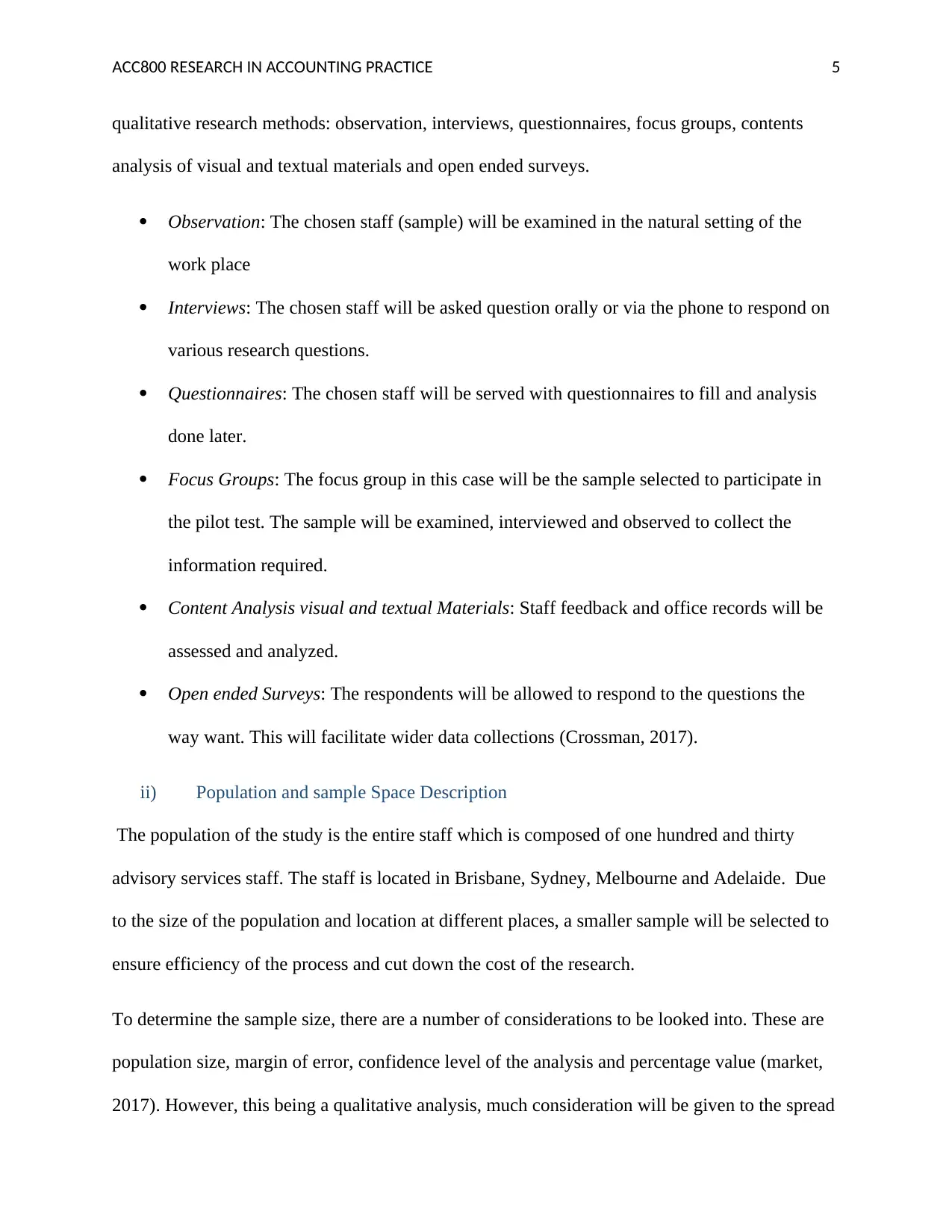
ACC800 RESEARCH IN ACCOUNTING PRACTICE 5
qualitative research methods: observation, interviews, questionnaires, focus groups, contents
analysis of visual and textual materials and open ended surveys.
Observation: The chosen staff (sample) will be examined in the natural setting of the
work place
Interviews: The chosen staff will be asked question orally or via the phone to respond on
various research questions.
Questionnaires: The chosen staff will be served with questionnaires to fill and analysis
done later.
Focus Groups: The focus group in this case will be the sample selected to participate in
the pilot test. The sample will be examined, interviewed and observed to collect the
information required.
Content Analysis visual and textual Materials: Staff feedback and office records will be
assessed and analyzed.
Open ended Surveys: The respondents will be allowed to respond to the questions the
way want. This will facilitate wider data collections (Crossman, 2017).
ii) Population and sample Space Description
The population of the study is the entire staff which is composed of one hundred and thirty
advisory services staff. The staff is located in Brisbane, Sydney, Melbourne and Adelaide. Due
to the size of the population and location at different places, a smaller sample will be selected to
ensure efficiency of the process and cut down the cost of the research.
To determine the sample size, there are a number of considerations to be looked into. These are
population size, margin of error, confidence level of the analysis and percentage value (market,
2017). However, this being a qualitative analysis, much consideration will be given to the spread
qualitative research methods: observation, interviews, questionnaires, focus groups, contents
analysis of visual and textual materials and open ended surveys.
Observation: The chosen staff (sample) will be examined in the natural setting of the
work place
Interviews: The chosen staff will be asked question orally or via the phone to respond on
various research questions.
Questionnaires: The chosen staff will be served with questionnaires to fill and analysis
done later.
Focus Groups: The focus group in this case will be the sample selected to participate in
the pilot test. The sample will be examined, interviewed and observed to collect the
information required.
Content Analysis visual and textual Materials: Staff feedback and office records will be
assessed and analyzed.
Open ended Surveys: The respondents will be allowed to respond to the questions the
way want. This will facilitate wider data collections (Crossman, 2017).
ii) Population and sample Space Description
The population of the study is the entire staff which is composed of one hundred and thirty
advisory services staff. The staff is located in Brisbane, Sydney, Melbourne and Adelaide. Due
to the size of the population and location at different places, a smaller sample will be selected to
ensure efficiency of the process and cut down the cost of the research.
To determine the sample size, there are a number of considerations to be looked into. These are
population size, margin of error, confidence level of the analysis and percentage value (market,
2017). However, this being a qualitative analysis, much consideration will be given to the spread
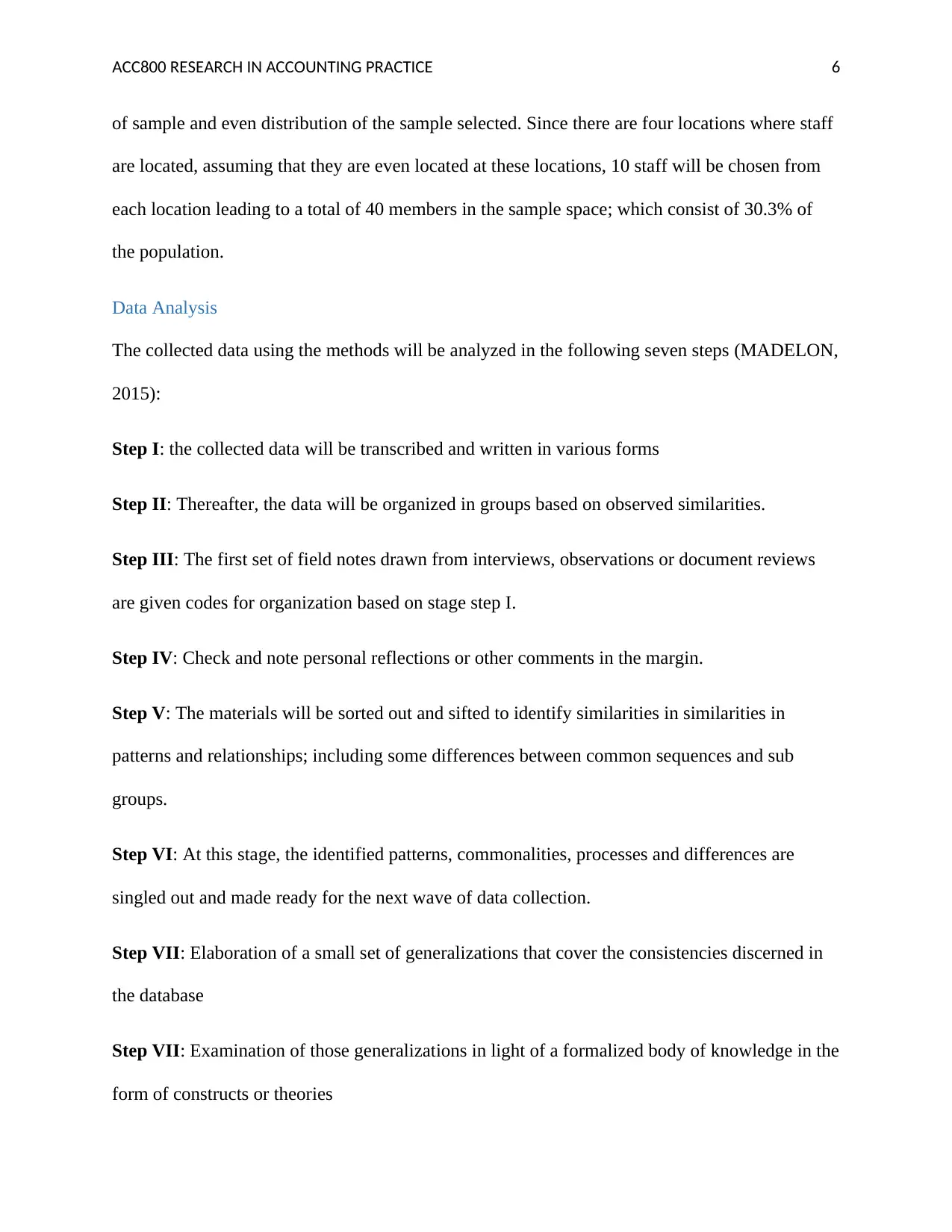
ACC800 RESEARCH IN ACCOUNTING PRACTICE 6
of sample and even distribution of the sample selected. Since there are four locations where staff
are located, assuming that they are even located at these locations, 10 staff will be chosen from
each location leading to a total of 40 members in the sample space; which consist of 30.3% of
the population.
Data Analysis
The collected data using the methods will be analyzed in the following seven steps (MADELON,
2015):
Step I: the collected data will be transcribed and written in various forms
Step II: Thereafter, the data will be organized in groups based on observed similarities.
Step III: The first set of field notes drawn from interviews, observations or document reviews
are given codes for organization based on stage step I.
Step IV: Check and note personal reflections or other comments in the margin.
Step V: The materials will be sorted out and sifted to identify similarities in similarities in
patterns and relationships; including some differences between common sequences and sub
groups.
Step VI: At this stage, the identified patterns, commonalities, processes and differences are
singled out and made ready for the next wave of data collection.
Step VII: Elaboration of a small set of generalizations that cover the consistencies discerned in
the database
Step VII: Examination of those generalizations in light of a formalized body of knowledge in the
form of constructs or theories
of sample and even distribution of the sample selected. Since there are four locations where staff
are located, assuming that they are even located at these locations, 10 staff will be chosen from
each location leading to a total of 40 members in the sample space; which consist of 30.3% of
the population.
Data Analysis
The collected data using the methods will be analyzed in the following seven steps (MADELON,
2015):
Step I: the collected data will be transcribed and written in various forms
Step II: Thereafter, the data will be organized in groups based on observed similarities.
Step III: The first set of field notes drawn from interviews, observations or document reviews
are given codes for organization based on stage step I.
Step IV: Check and note personal reflections or other comments in the margin.
Step V: The materials will be sorted out and sifted to identify similarities in similarities in
patterns and relationships; including some differences between common sequences and sub
groups.
Step VI: At this stage, the identified patterns, commonalities, processes and differences are
singled out and made ready for the next wave of data collection.
Step VII: Elaboration of a small set of generalizations that cover the consistencies discerned in
the database
Step VII: Examination of those generalizations in light of a formalized body of knowledge in the
form of constructs or theories
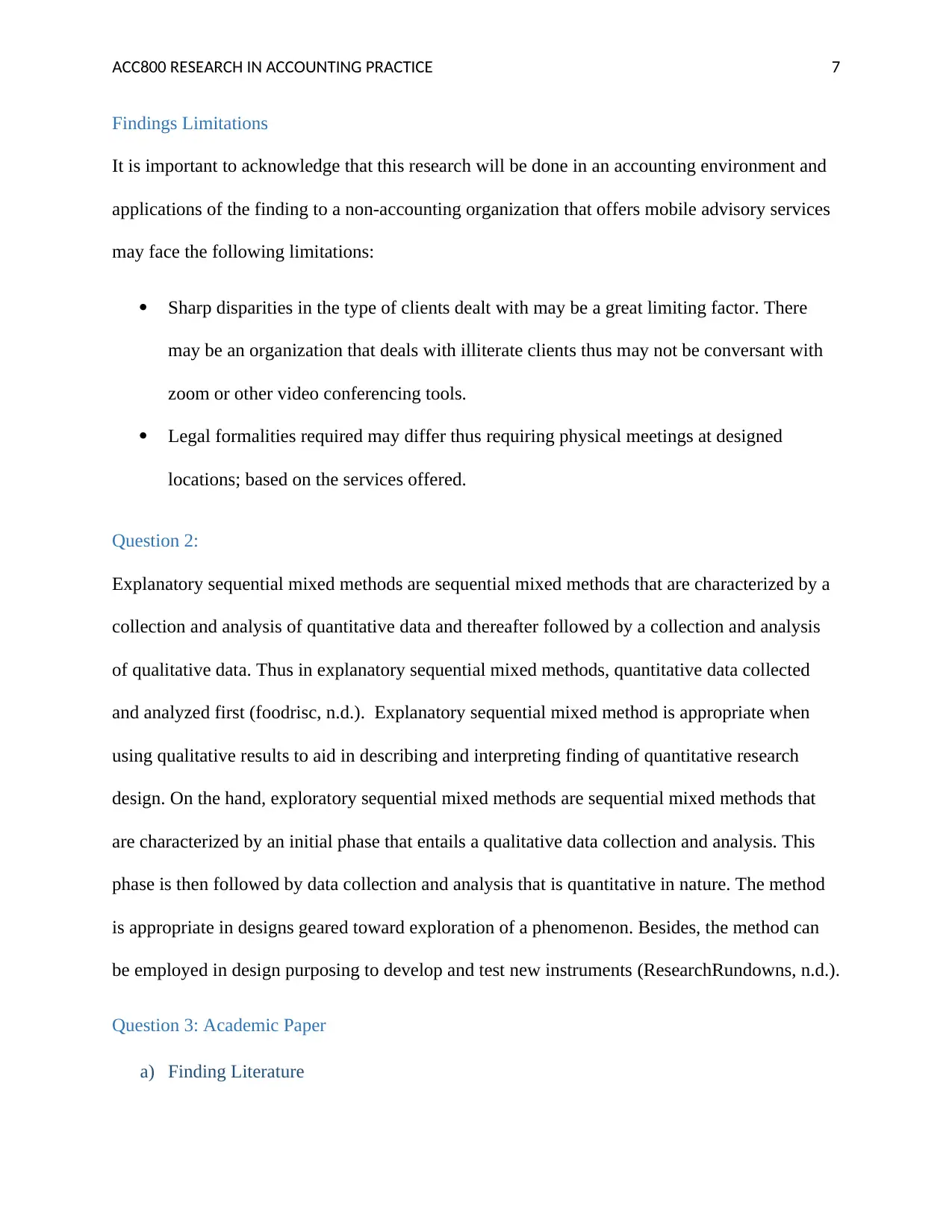
ACC800 RESEARCH IN ACCOUNTING PRACTICE 7
Findings Limitations
It is important to acknowledge that this research will be done in an accounting environment and
applications of the finding to a non-accounting organization that offers mobile advisory services
may face the following limitations:
Sharp disparities in the type of clients dealt with may be a great limiting factor. There
may be an organization that deals with illiterate clients thus may not be conversant with
zoom or other video conferencing tools.
Legal formalities required may differ thus requiring physical meetings at designed
locations; based on the services offered.
Question 2:
Explanatory sequential mixed methods are sequential mixed methods that are characterized by a
collection and analysis of quantitative data and thereafter followed by a collection and analysis
of qualitative data. Thus in explanatory sequential mixed methods, quantitative data collected
and analyzed first (foodrisc, n.d.). Explanatory sequential mixed method is appropriate when
using qualitative results to aid in describing and interpreting finding of quantitative research
design. On the hand, exploratory sequential mixed methods are sequential mixed methods that
are characterized by an initial phase that entails a qualitative data collection and analysis. This
phase is then followed by data collection and analysis that is quantitative in nature. The method
is appropriate in designs geared toward exploration of a phenomenon. Besides, the method can
be employed in design purposing to develop and test new instruments (ResearchRundowns, n.d.).
Question 3: Academic Paper
a) Finding Literature
Findings Limitations
It is important to acknowledge that this research will be done in an accounting environment and
applications of the finding to a non-accounting organization that offers mobile advisory services
may face the following limitations:
Sharp disparities in the type of clients dealt with may be a great limiting factor. There
may be an organization that deals with illiterate clients thus may not be conversant with
zoom or other video conferencing tools.
Legal formalities required may differ thus requiring physical meetings at designed
locations; based on the services offered.
Question 2:
Explanatory sequential mixed methods are sequential mixed methods that are characterized by a
collection and analysis of quantitative data and thereafter followed by a collection and analysis
of qualitative data. Thus in explanatory sequential mixed methods, quantitative data collected
and analyzed first (foodrisc, n.d.). Explanatory sequential mixed method is appropriate when
using qualitative results to aid in describing and interpreting finding of quantitative research
design. On the hand, exploratory sequential mixed methods are sequential mixed methods that
are characterized by an initial phase that entails a qualitative data collection and analysis. This
phase is then followed by data collection and analysis that is quantitative in nature. The method
is appropriate in designs geared toward exploration of a phenomenon. Besides, the method can
be employed in design purposing to develop and test new instruments (ResearchRundowns, n.d.).
Question 3: Academic Paper
a) Finding Literature
Paraphrase This Document
Need a fresh take? Get an instant paraphrase of this document with our AI Paraphraser
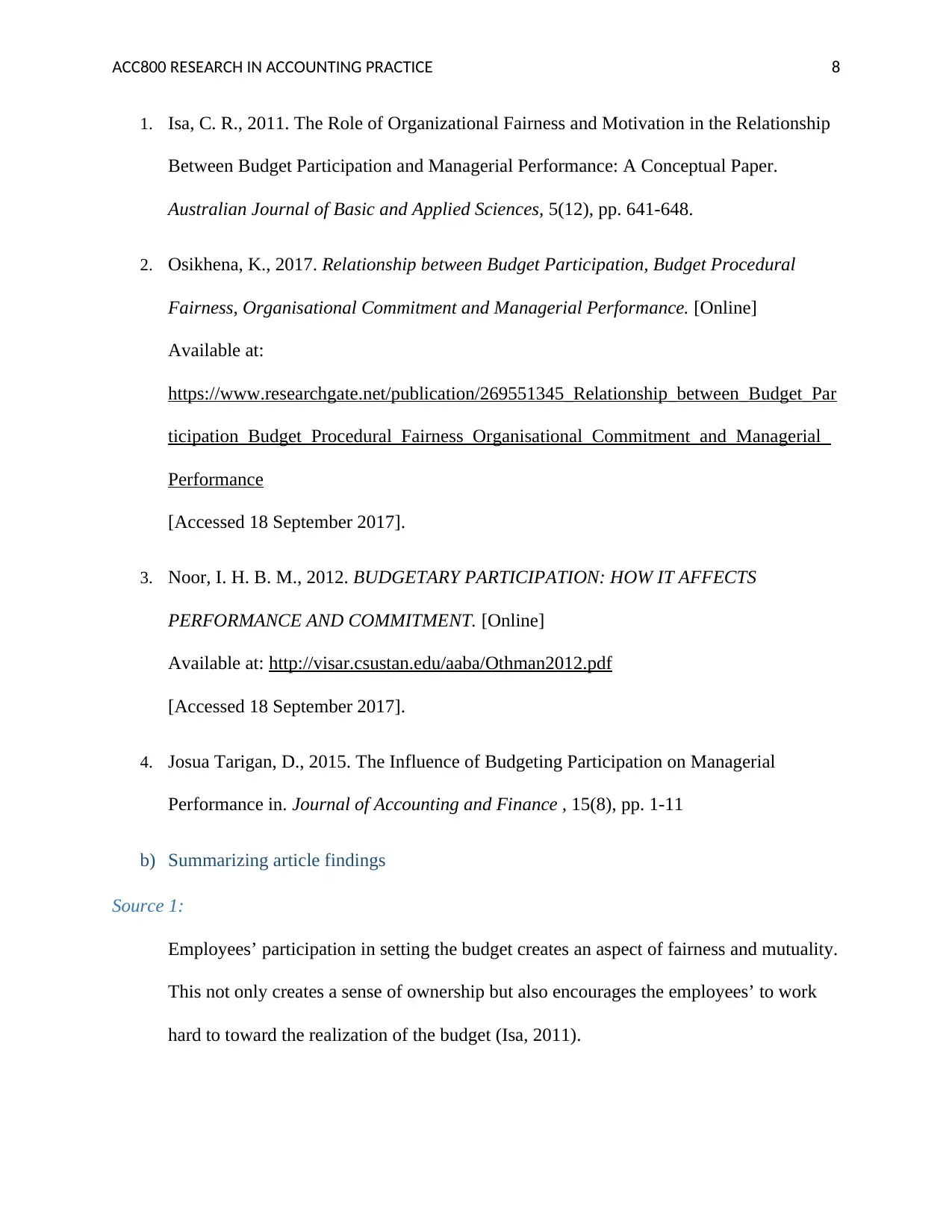
ACC800 RESEARCH IN ACCOUNTING PRACTICE 8
1. Isa, C. R., 2011. The Role of Organizational Fairness and Motivation in the Relationship
Between Budget Participation and Managerial Performance: A Conceptual Paper.
Australian Journal of Basic and Applied Sciences, 5(12), pp. 641-648.
2. Osikhena, K., 2017. Relationship between Budget Participation, Budget Procedural
Fairness, Organisational Commitment and Managerial Performance. [Online]
Available at:
https://www.researchgate.net/publication/269551345_Relationship_between_Budget_Par
ticipation_Budget_Procedural_Fairness_Organisational_Commitment_and_Managerial_
Performance
[Accessed 18 September 2017].
3. Noor, I. H. B. M., 2012. BUDGETARY PARTICIPATION: HOW IT AFFECTS
PERFORMANCE AND COMMITMENT. [Online]
Available at: http://visar.csustan.edu/aaba/Othman2012.pdf
[Accessed 18 September 2017].
4. Josua Tarigan, D., 2015. The Influence of Budgeting Participation on Managerial
Performance in. Journal of Accounting and Finance , 15(8), pp. 1-11
b) Summarizing article findings
Source 1:
Employees’ participation in setting the budget creates an aspect of fairness and mutuality.
This not only creates a sense of ownership but also encourages the employees’ to work
hard to toward the realization of the budget (Isa, 2011).
1. Isa, C. R., 2011. The Role of Organizational Fairness and Motivation in the Relationship
Between Budget Participation and Managerial Performance: A Conceptual Paper.
Australian Journal of Basic and Applied Sciences, 5(12), pp. 641-648.
2. Osikhena, K., 2017. Relationship between Budget Participation, Budget Procedural
Fairness, Organisational Commitment and Managerial Performance. [Online]
Available at:
https://www.researchgate.net/publication/269551345_Relationship_between_Budget_Par
ticipation_Budget_Procedural_Fairness_Organisational_Commitment_and_Managerial_
Performance
[Accessed 18 September 2017].
3. Noor, I. H. B. M., 2012. BUDGETARY PARTICIPATION: HOW IT AFFECTS
PERFORMANCE AND COMMITMENT. [Online]
Available at: http://visar.csustan.edu/aaba/Othman2012.pdf
[Accessed 18 September 2017].
4. Josua Tarigan, D., 2015. The Influence of Budgeting Participation on Managerial
Performance in. Journal of Accounting and Finance , 15(8), pp. 1-11
b) Summarizing article findings
Source 1:
Employees’ participation in setting the budget creates an aspect of fairness and mutuality.
This not only creates a sense of ownership but also encourages the employees’ to work
hard to toward the realization of the budget (Isa, 2011).
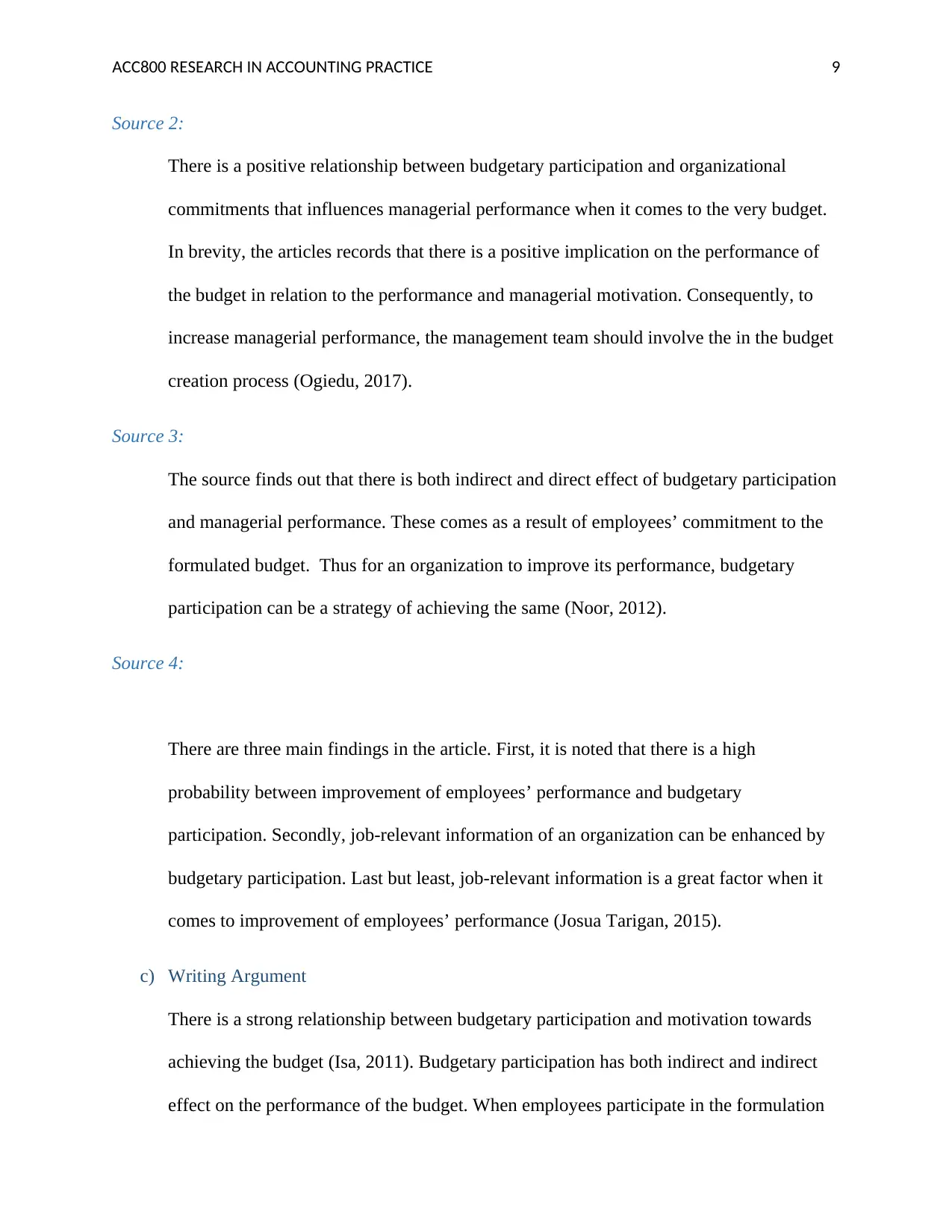
ACC800 RESEARCH IN ACCOUNTING PRACTICE 9
Source 2:
There is a positive relationship between budgetary participation and organizational
commitments that influences managerial performance when it comes to the very budget.
In brevity, the articles records that there is a positive implication on the performance of
the budget in relation to the performance and managerial motivation. Consequently, to
increase managerial performance, the management team should involve the in the budget
creation process (Ogiedu, 2017).
Source 3:
The source finds out that there is both indirect and direct effect of budgetary participation
and managerial performance. These comes as a result of employees’ commitment to the
formulated budget. Thus for an organization to improve its performance, budgetary
participation can be a strategy of achieving the same (Noor, 2012).
Source 4:
There are three main findings in the article. First, it is noted that there is a high
probability between improvement of employees’ performance and budgetary
participation. Secondly, job-relevant information of an organization can be enhanced by
budgetary participation. Last but least, job-relevant information is a great factor when it
comes to improvement of employees’ performance (Josua Tarigan, 2015).
c) Writing Argument
There is a strong relationship between budgetary participation and motivation towards
achieving the budget (Isa, 2011). Budgetary participation has both indirect and indirect
effect on the performance of the budget. When employees participate in the formulation
Source 2:
There is a positive relationship between budgetary participation and organizational
commitments that influences managerial performance when it comes to the very budget.
In brevity, the articles records that there is a positive implication on the performance of
the budget in relation to the performance and managerial motivation. Consequently, to
increase managerial performance, the management team should involve the in the budget
creation process (Ogiedu, 2017).
Source 3:
The source finds out that there is both indirect and direct effect of budgetary participation
and managerial performance. These comes as a result of employees’ commitment to the
formulated budget. Thus for an organization to improve its performance, budgetary
participation can be a strategy of achieving the same (Noor, 2012).
Source 4:
There are three main findings in the article. First, it is noted that there is a high
probability between improvement of employees’ performance and budgetary
participation. Secondly, job-relevant information of an organization can be enhanced by
budgetary participation. Last but least, job-relevant information is a great factor when it
comes to improvement of employees’ performance (Josua Tarigan, 2015).
c) Writing Argument
There is a strong relationship between budgetary participation and motivation towards
achieving the budget (Isa, 2011). Budgetary participation has both indirect and indirect
effect on the performance of the budget. When employees participate in the formulation
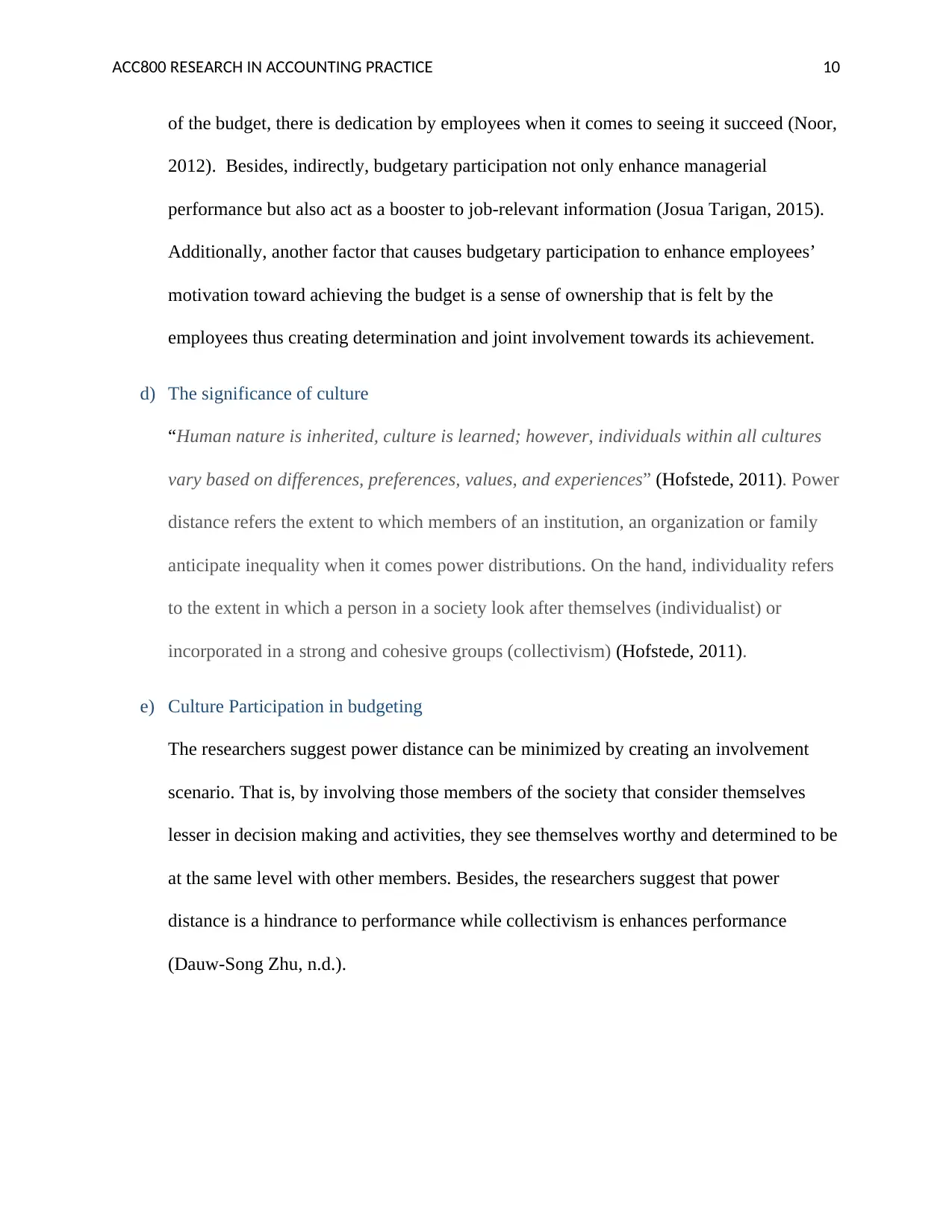
ACC800 RESEARCH IN ACCOUNTING PRACTICE 10
of the budget, there is dedication by employees when it comes to seeing it succeed (Noor,
2012). Besides, indirectly, budgetary participation not only enhance managerial
performance but also act as a booster to job-relevant information (Josua Tarigan, 2015).
Additionally, another factor that causes budgetary participation to enhance employees’
motivation toward achieving the budget is a sense of ownership that is felt by the
employees thus creating determination and joint involvement towards its achievement.
d) The significance of culture
“Human nature is inherited, culture is learned; however, individuals within all cultures
vary based on differences, preferences, values, and experiences” (Hofstede, 2011). Power
distance refers the extent to which members of an institution, an organization or family
anticipate inequality when it comes power distributions. On the hand, individuality refers
to the extent in which a person in a society look after themselves (individualist) or
incorporated in a strong and cohesive groups (collectivism) (Hofstede, 2011).
e) Culture Participation in budgeting
The researchers suggest power distance can be minimized by creating an involvement
scenario. That is, by involving those members of the society that consider themselves
lesser in decision making and activities, they see themselves worthy and determined to be
at the same level with other members. Besides, the researchers suggest that power
distance is a hindrance to performance while collectivism is enhances performance
(Dauw-Song Zhu, n.d.).
of the budget, there is dedication by employees when it comes to seeing it succeed (Noor,
2012). Besides, indirectly, budgetary participation not only enhance managerial
performance but also act as a booster to job-relevant information (Josua Tarigan, 2015).
Additionally, another factor that causes budgetary participation to enhance employees’
motivation toward achieving the budget is a sense of ownership that is felt by the
employees thus creating determination and joint involvement towards its achievement.
d) The significance of culture
“Human nature is inherited, culture is learned; however, individuals within all cultures
vary based on differences, preferences, values, and experiences” (Hofstede, 2011). Power
distance refers the extent to which members of an institution, an organization or family
anticipate inequality when it comes power distributions. On the hand, individuality refers
to the extent in which a person in a society look after themselves (individualist) or
incorporated in a strong and cohesive groups (collectivism) (Hofstede, 2011).
e) Culture Participation in budgeting
The researchers suggest power distance can be minimized by creating an involvement
scenario. That is, by involving those members of the society that consider themselves
lesser in decision making and activities, they see themselves worthy and determined to be
at the same level with other members. Besides, the researchers suggest that power
distance is a hindrance to performance while collectivism is enhances performance
(Dauw-Song Zhu, n.d.).
Secure Best Marks with AI Grader
Need help grading? Try our AI Grader for instant feedback on your assignments.
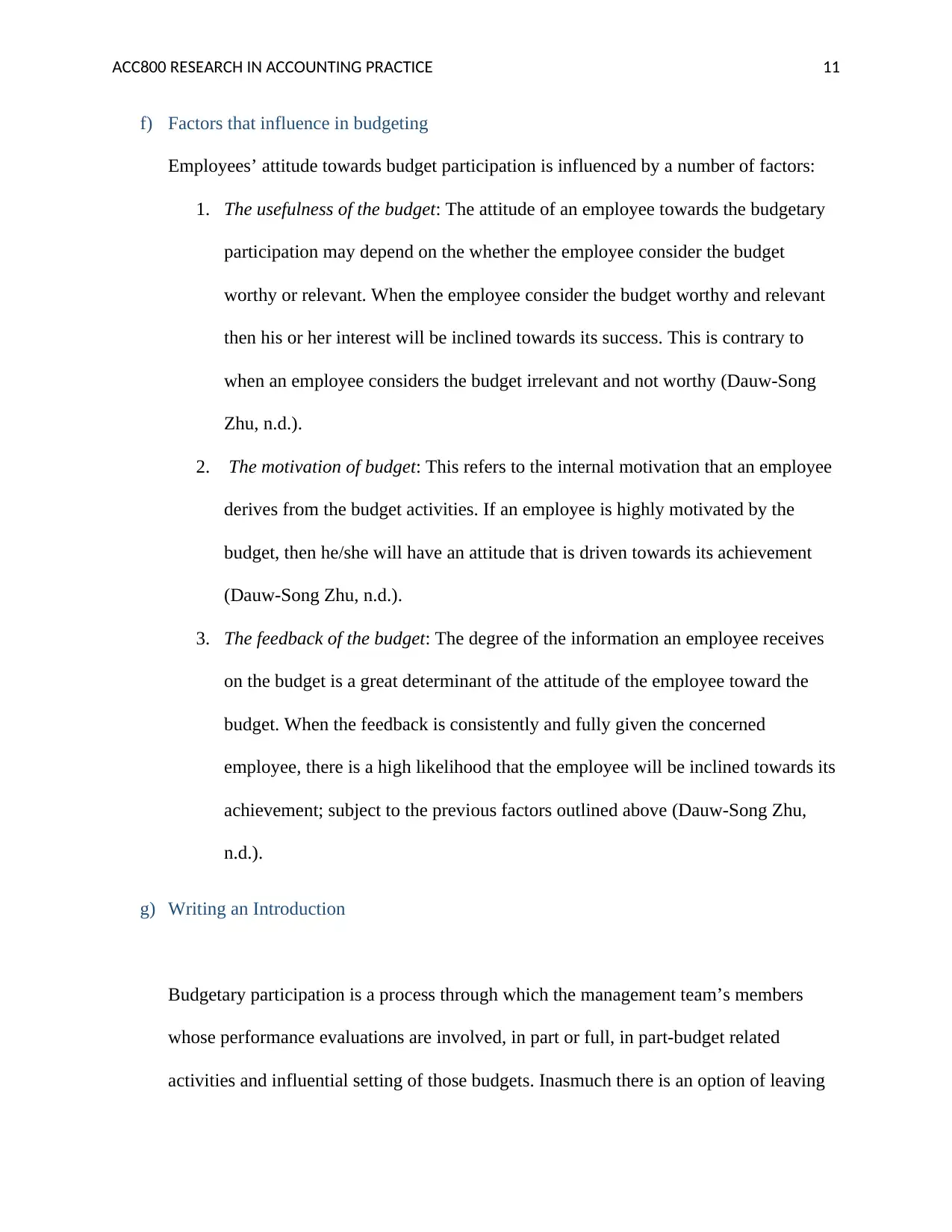
ACC800 RESEARCH IN ACCOUNTING PRACTICE 11
f) Factors that influence in budgeting
Employees’ attitude towards budget participation is influenced by a number of factors:
1. The usefulness of the budget: The attitude of an employee towards the budgetary
participation may depend on the whether the employee consider the budget
worthy or relevant. When the employee consider the budget worthy and relevant
then his or her interest will be inclined towards its success. This is contrary to
when an employee considers the budget irrelevant and not worthy (Dauw-Song
Zhu, n.d.).
2. The motivation of budget: This refers to the internal motivation that an employee
derives from the budget activities. If an employee is highly motivated by the
budget, then he/she will have an attitude that is driven towards its achievement
(Dauw-Song Zhu, n.d.).
3. The feedback of the budget: The degree of the information an employee receives
on the budget is a great determinant of the attitude of the employee toward the
budget. When the feedback is consistently and fully given the concerned
employee, there is a high likelihood that the employee will be inclined towards its
achievement; subject to the previous factors outlined above (Dauw-Song Zhu,
n.d.).
g) Writing an Introduction
Budgetary participation is a process through which the management team’s members
whose performance evaluations are involved, in part or full, in part-budget related
activities and influential setting of those budgets. Inasmuch there is an option of leaving
f) Factors that influence in budgeting
Employees’ attitude towards budget participation is influenced by a number of factors:
1. The usefulness of the budget: The attitude of an employee towards the budgetary
participation may depend on the whether the employee consider the budget
worthy or relevant. When the employee consider the budget worthy and relevant
then his or her interest will be inclined towards its success. This is contrary to
when an employee considers the budget irrelevant and not worthy (Dauw-Song
Zhu, n.d.).
2. The motivation of budget: This refers to the internal motivation that an employee
derives from the budget activities. If an employee is highly motivated by the
budget, then he/she will have an attitude that is driven towards its achievement
(Dauw-Song Zhu, n.d.).
3. The feedback of the budget: The degree of the information an employee receives
on the budget is a great determinant of the attitude of the employee toward the
budget. When the feedback is consistently and fully given the concerned
employee, there is a high likelihood that the employee will be inclined towards its
achievement; subject to the previous factors outlined above (Dauw-Song Zhu,
n.d.).
g) Writing an Introduction
Budgetary participation is a process through which the management team’s members
whose performance evaluations are involved, in part or full, in part-budget related
activities and influential setting of those budgets. Inasmuch there is an option of leaving
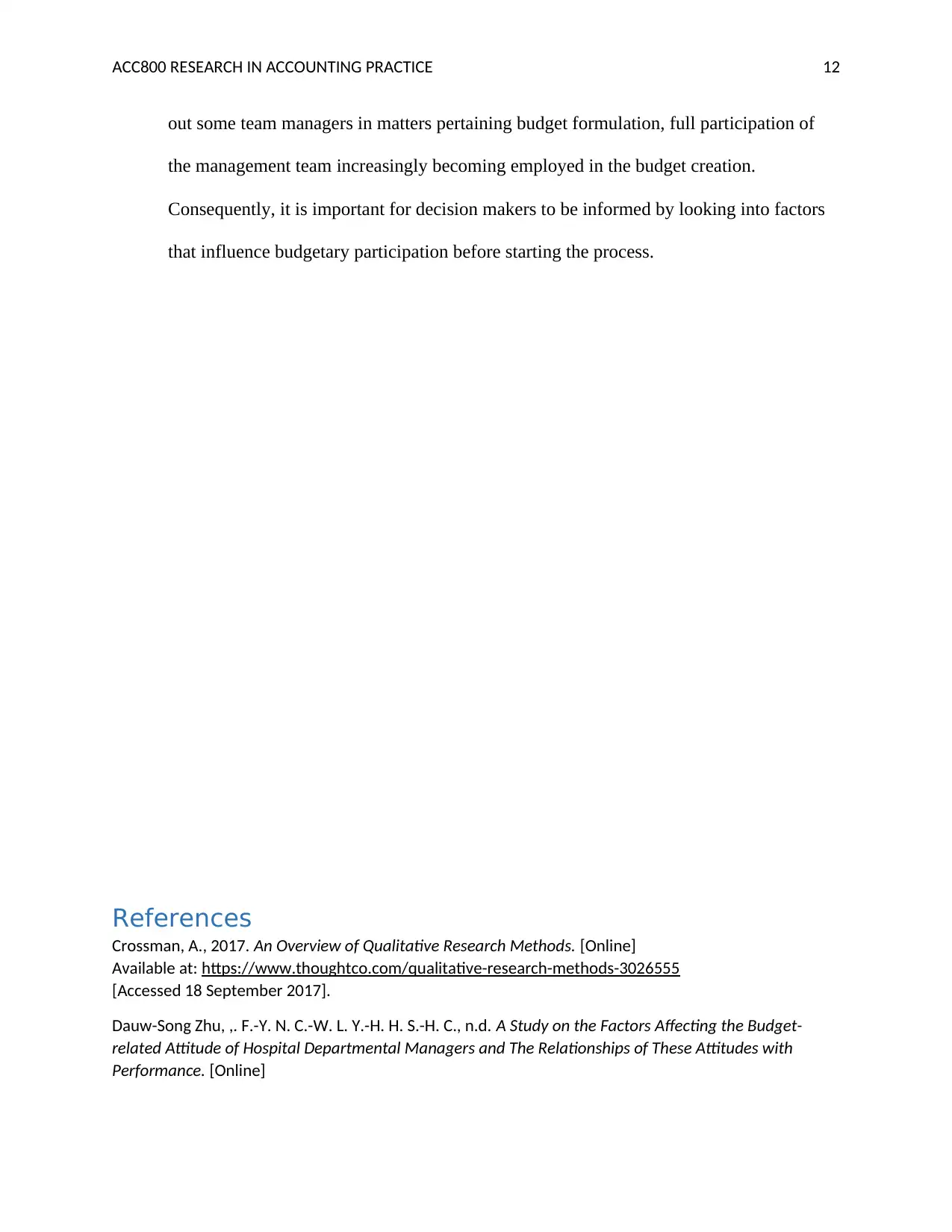
ACC800 RESEARCH IN ACCOUNTING PRACTICE 12
out some team managers in matters pertaining budget formulation, full participation of
the management team increasingly becoming employed in the budget creation.
Consequently, it is important for decision makers to be informed by looking into factors
that influence budgetary participation before starting the process.
References
Crossman, A., 2017. An Overview of Qualitative Research Methods. [Online]
Available at: https://www.thoughtco.com/qualitative-research-methods-3026555
[Accessed 18 September 2017].
Dauw-Song Zhu, ,. F.-Y. N. C.-W. L. Y.-H. H. S.-H. C., n.d. A Study on the Factors Affecting the Budget-
related Attitude of Hospital Departmental Managers and The Relationships of These Attitudes with
Performance. [Online]
out some team managers in matters pertaining budget formulation, full participation of
the management team increasingly becoming employed in the budget creation.
Consequently, it is important for decision makers to be informed by looking into factors
that influence budgetary participation before starting the process.
References
Crossman, A., 2017. An Overview of Qualitative Research Methods. [Online]
Available at: https://www.thoughtco.com/qualitative-research-methods-3026555
[Accessed 18 September 2017].
Dauw-Song Zhu, ,. F.-Y. N. C.-W. L. Y.-H. H. S.-H. C., n.d. A Study on the Factors Affecting the Budget-
related Attitude of Hospital Departmental Managers and The Relationships of These Attitudes with
Performance. [Online]
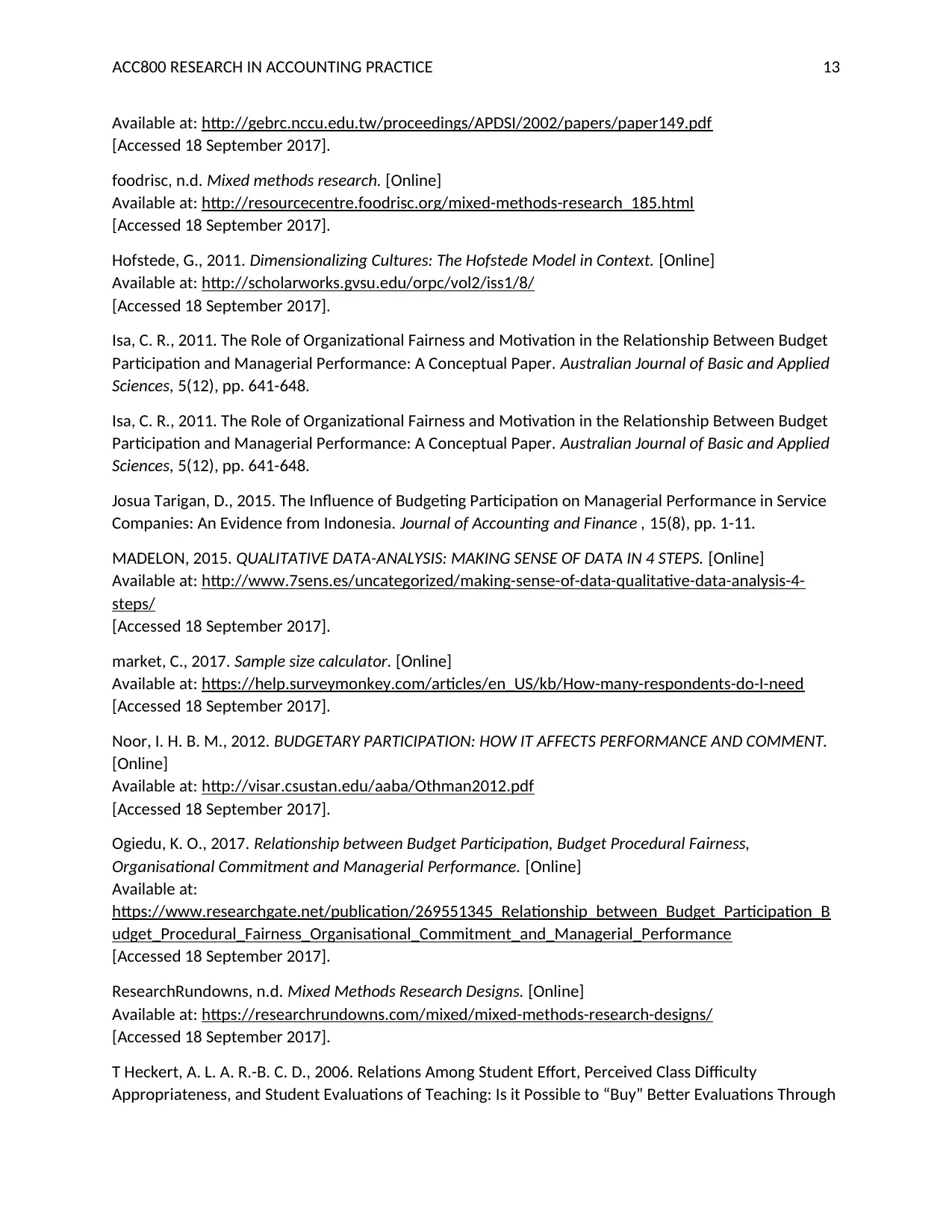
ACC800 RESEARCH IN ACCOUNTING PRACTICE 13
Available at: http://gebrc.nccu.edu.tw/proceedings/APDSI/2002/papers/paper149.pdf
[Accessed 18 September 2017].
foodrisc, n.d. Mixed methods research. [Online]
Available at: http://resourcecentre.foodrisc.org/mixed-methods-research_185.html
[Accessed 18 September 2017].
Hofstede, G., 2011. Dimensionalizing Cultures: The Hofstede Model in Context. [Online]
Available at: http://scholarworks.gvsu.edu/orpc/vol2/iss1/8/
[Accessed 18 September 2017].
Isa, C. R., 2011. The Role of Organizational Fairness and Motivation in the Relationship Between Budget
Participation and Managerial Performance: A Conceptual Paper. Australian Journal of Basic and Applied
Sciences, 5(12), pp. 641-648.
Isa, C. R., 2011. The Role of Organizational Fairness and Motivation in the Relationship Between Budget
Participation and Managerial Performance: A Conceptual Paper. Australian Journal of Basic and Applied
Sciences, 5(12), pp. 641-648.
Josua Tarigan, D., 2015. The Influence of Budgeting Participation on Managerial Performance in Service
Companies: An Evidence from Indonesia. Journal of Accounting and Finance , 15(8), pp. 1-11.
MADELON, 2015. QUALITATIVE DATA-ANALYSIS: MAKING SENSE OF DATA IN 4 STEPS. [Online]
Available at: http://www.7sens.es/uncategorized/making-sense-of-data-qualitative-data-analysis-4-
steps/
[Accessed 18 September 2017].
market, C., 2017. Sample size calculator. [Online]
Available at: https://help.surveymonkey.com/articles/en_US/kb/How-many-respondents-do-I-need
[Accessed 18 September 2017].
Noor, I. H. B. M., 2012. BUDGETARY PARTICIPATION: HOW IT AFFECTS PERFORMANCE AND COMMENT.
[Online]
Available at: http://visar.csustan.edu/aaba/Othman2012.pdf
[Accessed 18 September 2017].
Ogiedu, K. O., 2017. Relationship between Budget Participation, Budget Procedural Fairness,
Organisational Commitment and Managerial Performance. [Online]
Available at:
https://www.researchgate.net/publication/269551345_Relationship_between_Budget_Participation_B
udget_Procedural_Fairness_Organisational_Commitment_and_Managerial_Performance
[Accessed 18 September 2017].
ResearchRundowns, n.d. Mixed Methods Research Designs. [Online]
Available at: https://researchrundowns.com/mixed/mixed-methods-research-designs/
[Accessed 18 September 2017].
T Heckert, A. L. A. R.-B. C. D., 2006. Relations Among Student Effort, Perceived Class Difficulty
Appropriateness, and Student Evaluations of Teaching: Is it Possible to “Buy” Better Evaluations Through
Available at: http://gebrc.nccu.edu.tw/proceedings/APDSI/2002/papers/paper149.pdf
[Accessed 18 September 2017].
foodrisc, n.d. Mixed methods research. [Online]
Available at: http://resourcecentre.foodrisc.org/mixed-methods-research_185.html
[Accessed 18 September 2017].
Hofstede, G., 2011. Dimensionalizing Cultures: The Hofstede Model in Context. [Online]
Available at: http://scholarworks.gvsu.edu/orpc/vol2/iss1/8/
[Accessed 18 September 2017].
Isa, C. R., 2011. The Role of Organizational Fairness and Motivation in the Relationship Between Budget
Participation and Managerial Performance: A Conceptual Paper. Australian Journal of Basic and Applied
Sciences, 5(12), pp. 641-648.
Isa, C. R., 2011. The Role of Organizational Fairness and Motivation in the Relationship Between Budget
Participation and Managerial Performance: A Conceptual Paper. Australian Journal of Basic and Applied
Sciences, 5(12), pp. 641-648.
Josua Tarigan, D., 2015. The Influence of Budgeting Participation on Managerial Performance in Service
Companies: An Evidence from Indonesia. Journal of Accounting and Finance , 15(8), pp. 1-11.
MADELON, 2015. QUALITATIVE DATA-ANALYSIS: MAKING SENSE OF DATA IN 4 STEPS. [Online]
Available at: http://www.7sens.es/uncategorized/making-sense-of-data-qualitative-data-analysis-4-
steps/
[Accessed 18 September 2017].
market, C., 2017. Sample size calculator. [Online]
Available at: https://help.surveymonkey.com/articles/en_US/kb/How-many-respondents-do-I-need
[Accessed 18 September 2017].
Noor, I. H. B. M., 2012. BUDGETARY PARTICIPATION: HOW IT AFFECTS PERFORMANCE AND COMMENT.
[Online]
Available at: http://visar.csustan.edu/aaba/Othman2012.pdf
[Accessed 18 September 2017].
Ogiedu, K. O., 2017. Relationship between Budget Participation, Budget Procedural Fairness,
Organisational Commitment and Managerial Performance. [Online]
Available at:
https://www.researchgate.net/publication/269551345_Relationship_between_Budget_Participation_B
udget_Procedural_Fairness_Organisational_Commitment_and_Managerial_Performance
[Accessed 18 September 2017].
ResearchRundowns, n.d. Mixed Methods Research Designs. [Online]
Available at: https://researchrundowns.com/mixed/mixed-methods-research-designs/
[Accessed 18 September 2017].
T Heckert, A. L. A. R.-B. C. D., 2006. Relations Among Student Effort, Perceived Class Difficulty
Appropriateness, and Student Evaluations of Teaching: Is it Possible to “Buy” Better Evaluations Through
Paraphrase This Document
Need a fresh take? Get an instant paraphrase of this document with our AI Paraphraser

ACC800 RESEARCH IN ACCOUNTING PRACTICE 14
Lenient Grading?. College Student Journal, 40(3), pp. 588-596.
techtarget, 2017. web conferencing. [Online]
Available at: http://searchunifiedcommunications.techtarget.com/definition/Web-conferencing
[Accessed 18 September 2017].
Lenient Grading?. College Student Journal, 40(3), pp. 588-596.
techtarget, 2017. web conferencing. [Online]
Available at: http://searchunifiedcommunications.techtarget.com/definition/Web-conferencing
[Accessed 18 September 2017].
1 out of 14
Related Documents
Your All-in-One AI-Powered Toolkit for Academic Success.
+13062052269
info@desklib.com
Available 24*7 on WhatsApp / Email
![[object Object]](/_next/static/media/star-bottom.7253800d.svg)
Unlock your academic potential
© 2024 | Zucol Services PVT LTD | All rights reserved.





